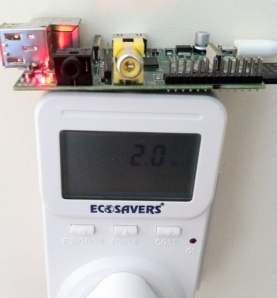Archive
First slice of Pi
I have had a chance to do some power draw monitoring of my Raspberry Pi and to compare with other low power ARM devices devices such as the SheevaPlug. The Raspberry Pi is really hard to beat – pulling roughly 2.0w when idle (with nothing plugged in to the USB or A/V outputs) to 3.2-3.3w at load (with HDMI output and USB keyboard and mouse) when using a standard Amazon Kindle charger as the power source. Something I’ve not had a moment to try is decoding HD video as I’d imagine that would load both the CPU and GPU but I can’t see the load being much higher given the combined CPU and GPU part (I’ll update this post when I confirm this).

Contrast these figures against 4.0w idle to 4.9-5.2w load for the SheevaPlug (also without any USB attachments). Admittedly the SheevaPlug has a slightly faster (1.2Ghz vs 700Mhz) ARM processor than the Raspberry Pi, but it also lacks the RCA/HDMI video output circuitry and has a wonky integrated PSU.
Probably the biggest difference between power consumption of the two devices will be related to power supply efficiency. As I already mentioned, the SheevaPlugs are renowned for being let down by cheap and inadequate integrated power supplies. In fact, I’m on my second Plug for that very reason. Since there is no (easy) way to test both devices with the same power supply, any comparison should probably be taken with a grain of salt.
EEE 900 and Desktop Series
I have been holding off posting more information filtering through from the EEE camp until now. Most people are already aware that the 900 Series will be the second generation of the proven EEE brand from Asus. It uses the same form factor with some key differences in the hardware. Firstly, Asus have added a bigger (8.9″) at 1024×600 resolution TFT screen which is a welcome upgrade from the fairly anemic 700 series. On top of this, the screen will feature a touchscreen panel (previously added by a talented hardware hacker) despite Kevin Lin (VP Sales at ASUS) previously going on record dismissing the rumours that ASUS were looking into a touchscreen version. It is also likely the CPU will be upgraded although nothing concrete has been announced as well as rumours of GPS functionality in the future.

Not only that, but it appears multitouch, a technology highlighted by its wonderful implementation on the Apple iPhone, is also going to feature on the second generation laptop. This is likely to be limited to zooming in/out on photos as well as some page browsing tweaks. Apart from that, the 900 Series of EEE PC will also feature more flash memory (8 and 12Gb models being announced) as well as a hefty pricetag increase. According to ASUS, the RRP is likely to be around $500 when it starts to ship in a couple of months time.
Unfortunately, if what happened with the first generation EEE PCs repeats itself, we are likely to see the price tag of $50-80 more (especially in the UK and Europe.) The issue that concerns me here is that it slips out of the ultracheap ultraportable niche and starts to go head to head with cheap machines produced by the likes of Acer, Fujitsu Siemens and others. Whilst these machines are generally dreadfully underpowered, it is likely to dampen interest in the EEE 900 series which would be a shame.
UPDATE: An excellent video review from CeBIT2008 of the new EEE PC can be seen here.
Briefly I would also like to mention the EEE ‘desktop’ PC which has been rumoured for a while. Engadget are running a story with some leaked pictures purporting to be the EEE desktop, although ASUS have not confirmed such a product range is even in development let alone released any rough specifications. As an early prediction, I do not think these ‘slimline’ desktops will do particularly well. Laptops were a different story, they presented ‘light’ mobile computing without the encumbrances of price and weight. In a market filled with low power desktop PCs, the only thing that could make the EEE desktop systems competitive (and desirable) would be a crazily low price tag (~£100, maybe £160 tops) because otherwise they are simply trying to take a slice of another niche market which already has some hungry wolves circling.

Gnome Trick!
I think Gnome is really great, but in my tweaking today I realised (strange given the time I have spent looking at it already) that the recycle bin had been moved from a desktop icon to an applet on one of the task bars. Whilst this was an interesting change, I felt myself longing for a less cluttered bar and a more noticeable icon. There is a very simple way to restore the recycle bin. The obvious way (which I tried first) was to simply map a new launcher to trash: – whilst this does give a desktop icon, it is a static icon which does not inform when the trash is ‘full’ making it functionless.
The way to do it can be found in this rather good book. With a simple check box the icon can be re-enabled under gnome 2.20 (and previous versions too but I have not tested this.)
To do this, enter the terminal and type “conf-editor” which will launch the gnome equivalent of regedit.
Goto Apps > Nautlus and select Desktop.
Put a check on trash_icon_visible and close. 🙂
Click on the image to see my full desktop. 🙂

